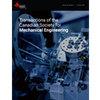Al%ZrO2镦粗过程硬度预测——一种基于回归和分类模型的机器学习方法
IF 1
4区 工程技术
Q4 ENGINEERING, MECHANICAL
Transactions of The Canadian Society for Mechanical Engineering
Pub Date : 2023-10-04
DOI:10.1139/tcsme-2023-0063
引用次数: 0
摘要
采用机器学习(ML)算法和有限元分析方法,对不同成分ZrO2包埋铝基体镦粗试验中金属硬度分布进行了预测。ZrO2颗粒的质量分数在4% ~ 8%之间,采用搅拌铸造法制备了Al4%ZrO2、Al6%ZrO2和Al8%ZrO2的3组固体圆柱形棒。对镦粗过程进行了模拟,并根据等效应变分布建立了硬度预测方程。以主应力、摩擦系数、各向异性比、有效应变和环向应变为输入参数,硬度大小为输出参数,利用人工神经网络(ANN)、多元线性回归(MLR)和有限元分析推导的方程对模型进行训练,进行回归分析。回归分析表明,对于给定的数据集,当均方根(R2)大于0.95时,ANN (Tri-layer network)、XG Boost和多元线性回归算法是最适合的。XG Boost、ANN (narrow)和SVM是线性的,是当前研究中最值得推荐的分类器算法。利用环压缩试验的硬度数据,将训练模型得到的结果与试验结果进行验证本文章由计算机程序翻译,如有差异,请以英文原文为准。
Hardness prediction in Upsetting process of Al%ZrO2 -An approach of Machine Learning using Regression and Classification Models
The current study focuses on the prediction of metal hardness distribution in the upsetting tests for different compositions of ZrO2 embedded with aluminum matrix using machine learning (ML) algorithms and finite element analysis. The mass fraction of the ZrO2 particles was varied from 4 % to 8% and 3 sets of solid cylindrical rods with Al4%ZrO2, Al6%ZrO2, and Al8%ZrO2 were prepared using the stir casting method. The upsetting process was simulated and an equation for predicting hardness was developed from the equivalent strain distributions. Artificial neural networks(ANN), Multilinear regression (MLR) along with equations developed from FE analysis were used to train the model for regression analysis considering the principal stresses, friction factor, anisotropy ratio, effective strain, and hoop strain as input and the magnitude of hardness as output parameters. Regression analysis reveals that ANN (Tri-layer network), XG Boost, and multilinear-regression algorithms are the best suitable for the given data sets with a root mean square (R2) greater than 0.95. XG Boost, ANN (narrow), and SVM are linear and are the most recommendable classifier algorithms for the current investigation. Hardness data from ring compression tests were used to validate the results obtained from the trained models with the test results
求助全文
通过发布文献求助,成功后即可免费获取论文全文。
去求助
来源期刊
CiteScore
2.30
自引率
0.00%
发文量
53
审稿时长
5 months
期刊介绍:
Published since 1972, Transactions of the Canadian Society for Mechanical Engineering is a quarterly journal that publishes comprehensive research articles and notes in the broad field of mechanical engineering. New advances in energy systems, biomechanics, engineering analysis and design, environmental engineering, materials technology, advanced manufacturing, mechatronics, MEMS, nanotechnology, thermo-fluids engineering, and transportation systems are featured.

 求助内容:
求助内容: 应助结果提醒方式:
应助结果提醒方式:


